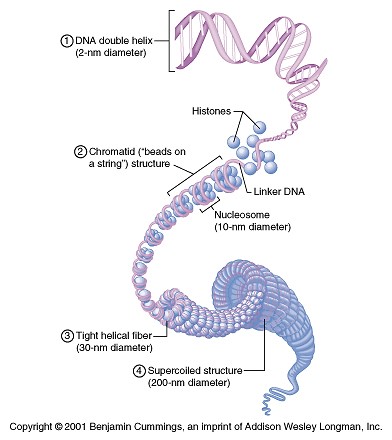Plant Genetic Material: DNA, Genes and Chromosomes, MCQ for GPAT, GATE, & CSIR NET
Structure of DNA
- DNA and RNA are nucleic acids found in plant cells. These nucleic acids are constructed from building blocks called nucleotides. A nucleotide is made of a nitrogen-containing base, a 5-carbon pentose sugar, and phosphate group. A sugar moiety in RNA is ribose hence it is called ribonucleic acid and the sugar moiety in DNA has one missing oxygen atom hence it is deoxyribose.
- The four nitrogenous bases, two Purines (Adenine, Guanine), Two Pyrimidines (Cytosine, Thymine) which makes up the base for DNA, whereas Uracil a demethylated form of Thymine, substitutes Thymine in RNA.
- Watson and crick model of DNA describes DNA structure as a ladder, twisted around a long axis to form a helical structure. Two molecules of DNA make this helix, hence it is called a double-helical structure.
- Sugar and phosphate molecules alternatively make a side of the ladder hence, it is known as sugar-phosphate backbone. The rungs of the ladder are always made of fixed base-pair of one Purine and Pyrimidine base. Purine base Adenine with Pyrimidine base Thymine (T), and Purine base Guanine (G) with Pyrimidine base Cytosine (C) are paired complementary to each other. These base pairs, Cytosine (C) and Guanine (G) are held with three hydrogen bonds whereas Adenine (A) and Thymine (T) with two hydrogen bonds.
- Two strands of DNA are complementary with each other, i.e. when one strand has Adenine, the complementary strand will have Thymine, when one strand has Guanine, and the other will have Cytosine and makes a whole double-helical structure.

Genes
- DNA having a particular sequence of nucleotides which encodes amino acid sequence for a particular protein is known as genes.
- Genes control the production of proteins in an individual cell.
- The characteristics of cells, tissues, organs, and organisms are controlled by the genes. Generally, genes are 1000 to 4000 nucleotides long in length.
- The entire genetic material (DNA) or genetic information in an organism or a cell is called a genome.
Chromosomes
- In an individual cell, the DNA is packed tightly into thread-like structures called chromosomes.
- Chromosomes consist of DNA and associated proteins. This Protein DNA complex is called chromatin.
- Generally, this genome in the plant cell nucleus is millions of times greater than the diameter of the nucleus. To pack such a large genome or chromosomal DNA within the nucleus, double strands of DNA are coiled twice around a solid cylinder of the eight proteins called a histone, to form a nucleosome.
- Along the length of the chromosome, these nucleosomes are arranged like beads on the string. DNA consists of heterochromatin a transcriptionally inactive form of chromatin and euchromatin a transcriptionally active form of chromatin.
- The nucleolus, a site for ribosome synthesis forms a dense granular region called nuclei. The nucleolus is composed of chromosomes in which rRNA (ribosomal RNA) genes are clustered. Each cell nucleus consists of one or more nucleoli. A complex of rRNA and specific proteins forms a small and a large subunit of 80s ribosomes.

Multiple-choice Questions
1.DNA structure as a ladder was developed by___
a) Watson and crick
b) William Astbury
c) Rosalind Franklin
d) Franklin and Wilkins
2. A sugar moiety present in DNA is called ________
a) Ribose
b) Deoxyribose
c) Deoxypentose
d) Pentose
3. The following are the nucleotides present in DNA Except:
a) Adenine
b) Guanine
c) Cytosine
d) Uracil
4. Which one of the following is a purine base for DNA
a) Guanine
b) Cytosine
c) Thiamine
d) Uracil
5. Which one of the following nitrogenous base is the demethylated form of Thymine
a) Guanine
b) Cytosine
c) Uracil
d) Adenine
6. Which of the following is the collect pair of nucleotide in DNA
a) Adenine- Uracil
b) Guanine-cytosine
c) Guanine-Adenine
d) Guanine-Thiamine
7. Each pair of nucleotide is held with _______
a) Nitrogen bond
b) Phosphate bond
c) Hydrogen bond
d) Carbon bond
8. Which of the following is the correct nucleotide pair in RNA
a) Adenine – Guanine
b) Adenine-thiamine
c) Adenine-Uracil
d) Adenine-cytosine
9. Genes are responsible for the production of ______
a) Carbohydrates
b) Fats
c) Proteins
d) Vitamins
10. Two subunits of Ribosome are synthesized in _________
a) Endoplasmic reticulum
b) Nucleus
c) Golgi bodies
d) Mitochondria
Answer Key
- a
- b
- d
- a
- c
- b
- c
- c
- c
- b
Reference
- G. Hopkins, Plant Biotechnology, 1st e.d. United States of America, Chelsea House publishers, 2007, Page: 50-55
- Taiz, E. Zeiger, Plant Physiology, 3rd e.d. Sinauer Associates, 2002, Page: 8-9